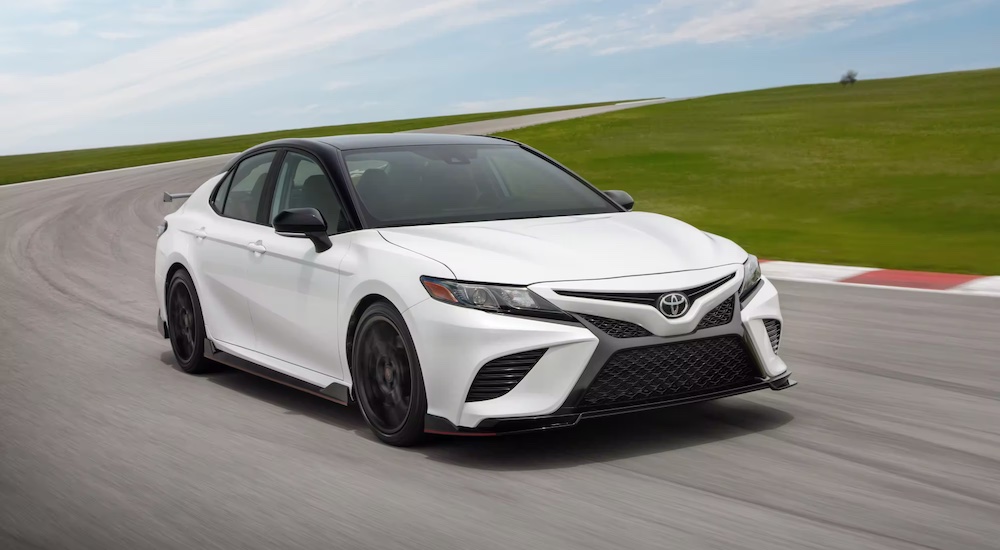Some vehicles fall victim to their own success, being neglected due to little more than their sheer popularity. The Toyota Camry is a great example of this unfortunate trend, with the sedan’s ubiquity causing too many drivers to overlook the best-selling model. Sure, they’ll still buy it in droves––Toyota moves over 300,000 units each year in the US alone; more than many brands sell across their entire lineup––but that level of demand doesn’t necessarily translate into excitement.
In 2020 Toyota set out to address this deficit, turning to its in-house racing team to develop a new high-performance version of the popular model that went a long way in renewing interest in the perennially popular sedan. The result is the Camry TRD, an overhauled version of the car that creates a little excitement when you see the words “Camry for sale.” Let’s take a look at the Camry’s history, the origins of the Toyota TRD racing program, and how the Camry TRD represents an exciting new offering that showcases the brand’s on-track success.
The Camry’s Surprisingly Sporty Story
Before we dig into the new TRD model, let’s take a quick look at the history of the Camry itself and see how a vehicle based on an obscure Japanese model became America’s best-selling sedan for almost a quarter century. You might be surprised to learn that the first vehicle to wear the Camry name wasn’t technically a Camry at all but a Toyota Celica.
The Celica Camry was offered as a four-door variant of the sporty Celica coupe starting in 1979. Despite its name, it had more in common with the Japanese-exclusive Toyota Carina. Toyota took the Carina chassis and stretched it out to make a more family-friendly car. Add a few styling flourishes lifted from the popular Celica, and the Camry was born, making an immediate impact on the market.
The Camry’s popularity was strong enough to warrant a standalone model starting in 1983, which was also the first year the sedan would be exported to the American market. Available as either a five-door hatchback or four-door sedan––it was the 1980s, after all––the Camry’s cabin was made more spacious to appeal to Western customers, but the most important change took place under the hood.
The four-door sedan was the king of the road at the time, with customers flocking to popular imports like the Honda Accord thanks to their seamless fusion of price, dependability, and comfort. The Camry offered these features in spades, but it was the upgraded engines that put the model over the top. Early Camry models featured a wider and more powerful selection of engines than the Accord, including a diesel option. While not exactly high-performance by today’s standards, the Camry was a refreshing change of pace in an era where thrifty, fuel-efficient compacts ruled the road.
Going Mainstream
For the third generation, Toyota made the fateful decision to put the passenger experience at the forefront––a departure from Honda’s approach that saw the driver as the target audience. Toyota redesigned the Camry to reduce in-cabin noise, making for a more peaceful and sophisticated ride for drivers and passengers alike. In addition to its new overhauled interior, the Camry also received a larger platform and an optional V6 engine as production was shifted to American shores.
In fact, this version was so well engineered that when Toyota needed a platform for its new Lexus ES entry-level luxury car, the Camry was the obvious choice. It was also around this time that American consumers got their first taste of what a performance-oriented Camry might look like with the introduction of the SE trim. The experiment wasn’t to last long with the SE nixed from the fourth generation––though it did include a V6 option with a manual transmission that served much the same purpose––but it was an interesting look at what was to come later with the Camry TRD.
Hitting the Track With TRD
To understand the power of models like the Camry TRD, it’s helpful to take a look at Toyota’s extensive history in motorsports. The automaker traces its racing lineage back to 1957 when it entered a Toyopet Crown in the Mobilgas Round Australia Rally. This race gave birth to the earliest iteration of Toyota’s in-house racing team, then known as Toyota Sports Corner (Tosco). The Crown wouldn’t turn any heads in today’s racing scene––or even be allowed on most highways––but it did the job well enough to propel the sedan over some 10,000 miles in 19 days.
Tosco started hitting its stride in the 1960s with an impressive series of wins at the 1963 Japanese Grand Prix, the 1967 Fuji 24-Hour Endurance Race, and the 1969 World Challenge Cup Fuji 200-Mile. Toyota would replicate this success in the US in 1973 when a Corolla earned its first World Rally Championship win at Michigan’s Press-on-Regardless Rally.
This success, and the associated marketing bump, inspired Toyota to step up its racing program in 1976, rebranding Tosco as Toyota Racing Development (TRD), beginning to offer high-performance parts and accessories for its production vehicles. The brand would continue to find success in the international racing circuit, but it was the uniquely American sport of desert racing that would lead to the creation of the first TRD model to enter mass production.
Looking for a way to showcase the durability and performance of the compact Toyota Tacoma pickup, TRD traded the racetrack for the trail and soon found itself picking up wins in off-road races that included the storied Mint 400, Baja 500, and Baja 1000. This success in the world of desert racing not only helped fill up Toyota’s trophy case but also saw the introduction of the production Tacoma TRD model. Built with a host of upgraded equipment perfect for tackling challenging off-road terrain, the original Tacoma TRD lives on today in models from the Tacoma TRD Pro to the RAV4 TRD Off-Road.
Toyota wasn’t ready to limit its high-performance experiments to the off-road circuit and soon set its sights on the most American motorsport: NASCAR cup racing. Toyota not only found success but broke some important barriers along the way as the first import auto manufacturer to race in a NASCAR event. The Tundra pickup found considerable success in the NASCAR Camping World Truck Series, picking up 12 Manufacturer’s Championship titles. That success continues to this day, with Toyota winning championships in all three of NASCAR’s top series thanks to TRD-designed V8 engines for the Tundra and Camry.
The Camry TRD Brings It All Home
Drivers finally got their chance to experience the high-speed fruits of TRD’s labor in a car with the 2020 Camry TRD. This race-inspired model is a breath of fresh air for the sedan market, which has come to be dominated by efficient––if unexciting––models in recent years. The Camry TRD turns that reputation on its head as one of the last family sedans to offer a V6 engine, adding a little thrill back to the everyday driving experience.
The Camry TRD comes with an array of high-performance upgrades that elevate the model far above the base-level sedan. The most notable improvement is the 3.5-liter V6 engine that can produce a roaring 301 hp and is paired with an eight-speed automatic transmission. Toyota also included plenty of exciting tech to up the Camry’s on-track credentials, such as a dedicated sport mode, paddle shifters, and a dual cat-back exhaust. The latter goes a long way in producing a hardy bellow that will let every other driver on the road know they’re not dealing with your average Camry.
Toyota has also redesigned the Camry TRD to offer improved control and ride feel. This includes thickening the sedan’s underbody braces for improved rigidity, adding TRD coil springs that lower the model by 0.6 inches, and adding stiffer stabilizer bars to decrease body roll. Upsized 12.9-inch rotors and dual-piston red brake calipers allow drivers to control the sedan’s considerable power and improve driver feedback. These enhancements, along with new TRD shock absorbers, lightweight 19-inch matte-black alloy wheels, and Bridgestone Potenza 235/40R19 summer tires, result in a responsive, sporty ride that adds excitement to even the most mundane of grocery runs.
The Camry TRD’s interior is equally distinctive, with a sport sedan-type cockpit that features black Sport SofTex front seats with fabric inserts, red accents, and red-stitched TRD embroidered headrests. Other sporty touches include a leather-wrapped steering wheel with red stitching and TRD badging throughout, including on the shift knob and floor mats. The sedan also sees the expected complement of interior conveniences, like a nine-inch infotainment system, automatic climate control, heated side mirrors, and keyless entry.
Truly Practical Performance
If you’re looking for a reliable everyday ride that can moonlight as a high-performance sports sedan, the Camry TRD represents an exciting new option for thrill-seeking drivers. Loaded with a considerable suite of high-end components and featuring a powerful V6 engine, the Camry is a true standout in the segment. The model’s performance credentials, along with the Camry’s longstanding reputation for reliability and comfort, make the Camry TRD a well-rounded option that’s sure to suit the needs of a wide variety of motorists.
The Camry has always pushed the boundaries when it comes to what a sedan can be, stretching back as far as the first American model in the early 1980s. Never content to just go with the flow, Toyota has bucked trends time and time again to deliver a truly unique product: a strategy that’s brought considerable success to this best-selling model. Given Toyota’s triumphs on the world racing circuit, it’s little surprise to see such an impressive display in a consumer-level product; our only complaint is that Toyota didn’t do this years ago. If nothing else, the Camry TRD allows Toyota to retain its stranglehold on the sedan market for the foreseeable future.






